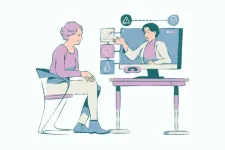(Press-News.org) High levels of carbon dioxide (CO2) in the atmosphere can alter not only the climate of our planet but also the functioning of our cells. The gas interacts with hydrogen peroxide (H2O2), which performs various functions in the human body, giving rise to a potent oxidant called peroxymonocarbonate.
"More and more evidence is emerging that peroxymonocarbonate is important in both cells’ adaptive responses via redox signaling and in cellular dysfunction. There is also epidemiological evidence that the levels of CO2 our cities are close to reaching cause a number of physiological problems. And the mechanisms underlying the toxicity of CO2 are poorly understood,” said Ohara Augusto, full professor at the University of São Paulo’s Chemistry Institute (IQ-USP) in Brazil.
An article on a study led by Augusto published in the journal Chemical Research in Toxicology describes a novel method of detecting peroxymonocarbonate in cells based on the use of fluorescent molecular probes. This is the first time the substance has been detected in cells. The study was conducted under the aegis of the Center for Research on Redox Processes in Biomedicine (Redoxome), a Research, Innovation and Dissemination Center (RIDC) funded by FAPESP.
“This research is important both because it has produced a method to show that peroxymonocarbonate is produced under certain conditions, including cellular conditions, and because it has raised this as a topic for discussion, a boon considering the scant attention paid to CO2 in the redox field,” Augusto said.
Measuring fluorescence
To detect peroxymonocarbonate, the researchers measured fluorescence from boronate probes. They first engineered an enzyme reaction that produced steady-state physiological concentrations of hydrogen peroxide and measured boronate probe fluorescence in the presence and absence of CO2. Boronates are used to detect hydrogen peroxide, peroxynitrite, hypochlorous acid and peroxymonocarbonate, among other substances, which react with them at different speeds and intensities, permitting the identification of these oxidants.
In the study, macrophages were activated to generate hydrogen peroxide. Macrophages are immune system cells that generate different oxidants, depending on the type of activation.
The researchers conducted several control experiments and concluded that the cells did not generate peroxynitrite or hypochlorous acid, but did generate peroxymonocarbonate in the presence of CO2.
“This is a relatively simple method for detecting peroxymonocarbonate in physiological concentrations of hydrogen peroxide and CO2. It used to be impossible, but researchers can now conclude that some effects observed in cells, such as higher oxidation of certain proteins or cell responses, may be due to peroxymonocarbonate, and they will be able to test this finding,” Augusto said.
Although peroxymonocarbonate has been known to chemists since the 1960s and has technological applications as a disinfectant and whitener, for example, its presence in cells was considered impossible owing to low concentrations of its precursors and a slow formation rate. According to Augusto, investigation of peroxymonocarbonate in biological systems began in the first decade of the millennium, initially with a focus on oxidative damage.
Redox signaling and CO2
Redox signaling is an adaptive response. “When stress increases slightly, the cell adapts. Formation of oxidants, for example, can lead to the expression of genes for antioxidant enzymes, responding to oxidative stress in this case. Moreover, many pathways that lead to cellular responses involve thiol proteins, which peroxymonocarbonate oxidizes faster than hydrogen peroxide,” Augusto said, adding that irreversible cellular damage occurs only when oxidant formation is very substantial.
Carbon dioxide is a precursor to peroxymonocarbonate, as is hydrogen peroxide. CO2 is naturally present in the atmosphere and in the human body. People exhale about 1.0 kg of CO2 per day on average as a product of their metabolism.
From a redox point of view, CO2 modulates the reactivity of hydrogen peroxide and peroxynitrite, two important metabolites of molecular oxygen. It also alters gene expression, including expression of genes involved in inflammation. And it is involved in protein nitration via peroxynitrite and in protein carbamylation, another post-translational modification that can alter the biological function of proteins.
Although more evidence of its role as a biological oxidant is needed, peroxymonocarbonate appears to be one of the possible intermediaries of the harmful effects of increased levels of CO2 in our bodies. Moreover, CO2 also acts through non-redox mechanisms, Augusto noted.
About São Paulo Research Foundation (FAPESP)
The São Paulo Research Foundation (FAPESP) is a public institution with the mission of supporting scientific research in all fields of knowledge by awarding scholarships, fellowships and grants to investigators linked with higher education and research institutions in the State of São Paulo, Brazil. FAPESP is aware that the very best research can only be done by working with the best researchers internationally. Therefore, it has established partnerships with funding agencies, higher education, private companies, and research organizations in other countries known for the quality of their research and has been encouraging scientists funded by its grants to further develop their international collaboration. You can learn more about FAPESP at www.fapesp.br/en and visit FAPESP news agency at www.agencia.fapesp.br/en to keep updated with the latest scientific breakthroughs FAPESP helps achieve through its many programs, awards and research centers. You may also subscribe to FAPESP news agency at http://agencia.fapesp.br/subscribe.
END
Novel method detects biological oxidant derived from CO2 in cells
A study conducted at the University of São Paulo in Brazil helps elucidate the impact of high levels of atmospheric carbon dioxide on human health.
2024-09-23
ELSE PRESS RELEASES FROM THIS DATE:
American Cancer Society experts presenting key research at 2024 ASCO Quality Care Symposium
2024-09-23
Scientists from the American Cancer Society (ACS) are presenting research studies at the 2024 Annual Meeting of the American Society of Clinical Oncology (ASCO) Quality Care Symposium (QCS) September 27-28 in San Francisco, CA. ASCO QCS offers research and education that encompasses the needs and viewpoints of multiple disciplines and various practice settings, attracting oncology professionals from around the world. This year’s program will feature studies complementing the meeting’s theme: “Driving Solutions, Implementing ...
New research identifies critical gaps in mental health care for adults with schizophrenia spectrum disorders
2024-09-23
New research finds that adults with schizophrenia spectrum disorders have high rates of comorbid mental and substance use disorders and significant social and economic disadvantages, and only 26% received minimally adequate treatment. Meeting the needs of people with schizophrenia spectrum disorders will require innovative interventions and implementation to improve access to and use of evidence-based approaches, the authors argue. The research was published today in Psychiatric Services in Advance.
The researchers, led by Natalie Bareis, Ph.D., ...
Advances in theranostics take center stage at SNMMI 2024 Therapeutics Conference
2024-09-23
Reston, VA (September 23, 2024)—More than 300 nuclear medicine clinicians, researchers, technologists, regulators and suppliers gathered in Bethesda, Maryland, on September 19-21, for the Society of Nuclear Medicine and Molecular Imaging (SNMMI) 2024 Therapeutics Conference. As the largest SNMMI Therapeutics Conference to date, the meeting offered attendees the chance to explore the latest innovations and advancements in theranostics and other nuclear medicine therapies as well as gain valuable insights into enhancing their practice.
This year’s Therapeutics Conference included eight distinct sessions covering advances in radiopharmaceutical ...
Firms that withdrew from Russia following Ukraine invasion earn higher consumer sentiment
2024-09-23
Following Russia’s 2022 invasion of Ukraine, many companies with operations in Russia withdrew from or severely curtailed their Russian operations. For example, Dell and McDonald’s ceased all operations in Russia after the invasion.
Many experts have argued that the corporate response to the Ukraine war is a striking example of stakeholder capitalism, a model where corporations are responsible for considering the interests of various stakeholders — including employees, customers, communities, governments and the environment — and not just ...
Biologist pioneers increased protein in staple crops, helps alleviate global protein shortage
2024-09-23
A Mississippi State biologist’s groundbreaking research in improving global nutrition and sustainability is featured this week in New Phytologist, a leading plant biology journal.
Ling Li, an associate professor in the MSU Department of Biological Sciences, has spent more than a decade studying rice and soybean crops, with the goal of providing a new strategy for crop improvement to increase protein content. Her work offers a potential solution to combat global protein deficiency, a condition affecting millions, particularly children, contributing to cognitive impairments, stunted growth and susceptibility to diseases like Kwashiorkor, ...
Wayne State University awarded grant to combat microplastics in the Great Lakes
2024-09-23
DETROIT — Wayne State University researchers recently received a grant from the Great Lakes Protection Fund to team with the Huron River Watershed Council, the Cleveland Water Alliance, Buffalo Niagara Waterkeeper and Resource Recycling Systems to help communities combat microplastics in water sources.
The project, “Mobilizing a Great Lakes Microplastic Action Network,” is led by Yongli Wager, Ph.D., associate professor of civil and environmental engineering and director of the Sustainable Water-Environment-Energy Technologies Lab in Wayne State’s College of Engineering. The project’s goal is to create ...
CU Anschutz experts identify key opportunities to strengthen climate education for health care professionals
2024-09-23
Doctors and researchers at the University of Colorado Anschutz Medical Campus published a discussion paper today highlighting key initiatives to help strengthen, train and prepare doctors and health care workers for the impact of climate change on human health.
The paper is published in the National Academy of Medicine Perspectives.
The authors, who come from a diverse background in health care from pediatrics to emergency medicine, and nursing to pharmacy, outline the importance of educating a climate-savvy health care workforce and highlight educational opportunities to fulfill the critical need.
“As climate change increasingly ...
Telemedicine improved doctors’ quality of patient care during COVID pandemic, new study shows
2024-09-23
BINGHAMTON, N.Y. -- Telemedicine actually improves the quality of care and increases physician satisfaction in delivering that care, according to new research from Binghamton University, State University of New York.
We all remember when the COVID-19 lockdown in early 2020 upended the comfort of our daily routines. Businesses were forced to adapt to limited ways of engaging with customers, with varied levels of success.
Lockdown posed a unique challenge for physicians: they couldn’t meet with every patient in person. Telemedicine became not only an alternative but the best option for seeing patients in remote areas or where infection rates ...
DECam confirms that early-universe quasar neighborhoods are indeed cluttered
2024-09-23
Quasars are the most luminous objects in the Universe and are powered by material accreting onto supermassive black holes at the centers of galaxies. Studies have shown that early-Universe quasars have black holes so massive that they must have been swallowing gas at very high rates, leading most astronomers to believe that these quasars formed in some of the densest environments in the Universe where gas was most available. However, observational measurements seeking to confirm this conclusion have thus far yielded conflicting results. Now, a new study using the Dark Energy Camera ...
Kashanchi studying parasite-derived vesicles in babesia virulence and vaccine development
2024-09-23
Fatah Kashanchi, Professor, Virology, School of Systems Biology, College of Science; Director, Laboratory of Molecular Virology, received funding for the study: “Parasite-Derived Vesicles in Babesia virulence and Vaccine Development.”
Babesia is a parasite spread by ticks. If humans contract babesiosis, they can experience influenza-like symptoms, bleeding, and organ failure. The condition is rare and affects fewer than 3,000 people in the United States per year.
Kashanchi will isolate extracellular vesicles (EVs) and utilize them to treat primary monocyte-derived macrophages ...
LAST 30 PRESS RELEASES:
Why nail-biting, procrastination and other self-sabotaging behaviors are rooted in survival instincts
Regional variations in mechanical properties of porcine leptomeninges
Artificial empathy in therapy and healthcare: advancements in interpersonal interaction technologies
Why some brains switch gears more efficiently than others
UVA’s Jundong Li wins ICDM’S 2025 Tao Li Award for data mining, machine learning
UVA’s low-power, high-performance computer power player Mircea Stan earns National Academy of Inventors fellowship
Not playing by the rules: USU researcher explores filamentous algae dynamics in rivers
Do our body clocks influence our risk of dementia?
Anthropologists offer new evidence of bipedalism in long-debated fossil discovery
Safer receipt paper from wood
Dosage-sensitive genes suggest no whole-genome duplications in ancestral angiosperm
First ancient human herpesvirus genomes document their deep history with humans
Why Some Bacteria Survive Antibiotics and How to Stop Them - New study reveals that bacteria can survive antibiotic treatment through two fundamentally different “shutdown modes”
UCLA study links scar healing to dangerous placenta condition
CHANGE-seq-BE finds off-target changes in the genome from base editors
The Journal of Nuclear Medicine Ahead-of-Print Tip Sheet: January 2, 2026
Delayed or absent first dose of measles, mumps, and rubella vaccination
Trends in US preterm birth rates by household income and race and ethnicity
Study identifies potential biomarker linked to progression and brain inflammation in multiple sclerosis
Many mothers in Norway do not show up for postnatal check-ups
Researchers want to find out why quick clay is so unstable
Superradiant spins show teamwork at the quantum scale
Cleveland Clinic Research links tumor bacteria to immunotherapy resistance in head and neck cancer
First Editorial of 2026: Resisting AI slop
Joint ground- and space-based observations reveal Saturn-mass rogue planet
Inheritable genetic variant offers protection against blood cancer risk and progression
Pigs settled Pacific islands alongside early human voyagers
A Coral reef’s daily pulse reshapes microbes in surrounding waters
EAST Tokamak experiments exceed plasma density limit, offering new approach to fusion ignition
Groundbreaking discovery reveals Africa’s oldest cremation pyre and complex ritual practices
[Press-News.org] Novel method detects biological oxidant derived from CO2 in cellsA study conducted at the University of São Paulo in Brazil helps elucidate the impact of high levels of atmospheric carbon dioxide on human health.





